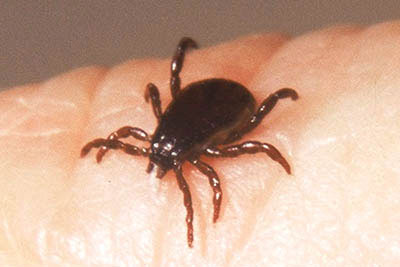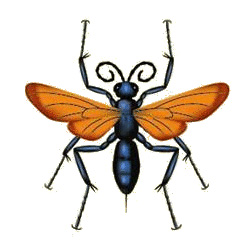Brown Dog Tick

Photo by D.C. Lightfoot
Arachnida, Acari, Ixodidae, Rhipicephalus sanguineus
Description: Adults are shiny dark brown, juveniles are shiny dark gray. Adult females that are attached to dogs become engorged with blood and developing eggs, and they are light gray and grape-like. The only common tick in urban areas.
Geographic Distribution: Found throughout New Mexico, but mostly restricted to urban areas.
Habitats: Yards and homes, always associated with dogs, and mostly in yards with dogs.
Biology: Brown dog ticks have a life cycle that includes: 10 egg, larva, nymph and adult stages. Adults climb on to vegetation or other structures, in the late spring (April/May) and climb on to passing dogs. They burrow their mouthparts into the dog's skin and feed on blood. Females become engorged with blood and enlarged and light gray. Usually mating adult males are found attached to the females, males remain small and dark brown. Females drop from dog hosts after a few days of feeding and lay eggs on the soil or in homes on rugs. Adults dog ticks are most common in New Mexico during the late spring and early summer months (May-June). The immature dog ticks are dark gray and search for dogs or other animals to feed on. They develop over the late summer and fall, and hibernate in the soil or leaf litter during the winter, and emerge as adults in the late spring. Dog ticks are specific to dogs, and rarely bite humans. Brown dog ticks can complete their entire life cycle indoors, feeding on dog blood and laying eggs indoors.
Health/pest Status: Dog ticks are a nuisance, and can cause scar injuries to dogs, and bacterial infections. Across the American Southwest, the brown dog tick can carry and transmit the pathogens canine ehrlichiosis (Ehrlichia canis) and canine babesiosis (Babesia canis) among dogs, and Rocky Mountain spotted fever (Rickettsia rickettsii), which can be transmitted to both dogs and humans. The brown dog tick is not known to carry or to transmit Lyme's disease.



